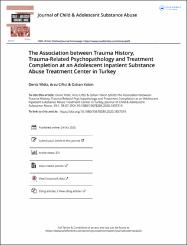| dc.contributor.author | Yıldız, Deniz | |
| dc.contributor.author | Çiftçi, Arzu | |
| dc.contributor.author | Yalçın, Özhan | |
| dc.date.accessioned | 2023-09-24T09:47:38Z | |
| dc.date.available | 2023-09-24T09:47:38Z | |
| dc.date.issued | 2020 | en_US |
| dc.identifier.issn | 1067-828X | |
| dc.identifier.issn | 1547-0652 | |
| dc.identifier.uri | https://hdl.handle.net/11363/5641 | |
| dc.description.abstract | Some adolescents are at great risk for early attrition from inpatient substance abuse treatment. We aimed to examine the effect of sociodemographic features, substance use patterns, childhood traumas and trauma-related psychopathology on the completion of an
adolescent substance abuse inpatient treatment program in order to acquire information
about adapting treatment strategies to enhance patient retention. Our study included 105
adolescents who were referred with a diagnosis of substance use disorder to our Child and
Adolescent Substance Abuse Treatment Center’s inpatient treatment program in Istanbul,
Turkey from February to December 2017. The Schedule for Affective Disorders and
Schizophrenia for School-Age Children-Present and Lifetime Version, the Hamilton
Depression Rating Scale, the Conners-Wells Adolescent Self Report Scale, the Childhood
Trauma Questionnaire, the Childhood Abuse and Neglect Question List, the Dependency
Profile Index-Practitioner Form and the Adolescent Dissociative Experiences Scale were
administered to the study group. The treatment completion rate was 26.7%. The patients
who did not complete the inpatient treatment program had more history of childhood
emotional neglect and/or abuse. The most common type of psychosocial trauma was emotional neglect (34%). Early attrition from the inpatient treatment program was related to dissociative amnesia, more severe attention deficit hyperactivity disorder, depression and
synthetic cannabinoids use (p < 0.05). Our findings indicate that childhood psychosocial
trauma and related clinical characteristics were associated with attrition from the adolescent
inpatient substance abuse treatment program. Substance abuse treatment programs should
adopt early assessment tools to identify those at risk for early attrition from treatment and
provide targeted interventions for them. | en_US |
| dc.language.iso | eng | en_US |
| dc.publisher | ROUTLEDGE JOURNALS, TAYLOR & FRANCIS LTD, 2-4 PARK SQUARE, MILTON PARK, ABINGDON OX14 4RN, OXON, ENGLAND | en_US |
| dc.relation.isversionof | 10.1080/1067828X.2020.1837319 | en_US |
| dc.rights | info:eu-repo/semantics/openAccess | en_US |
| dc.rights.uri | http://creativecommons.org/licenses/by-nc-nd/3.0/us/ | * |
| dc.subject | adolescents | en_US |
| dc.subject | psychosocial trauma | en_US |
| dc.subject | substance use disorder | en_US |
| dc.subject | treatment retention | en_US |
| dc.title | The Association between Trauma History, Trauma-Related Psychopathology and Treatment Completion at an Adolescent Inpatient Substance Abuse Treatment Center in Turkey | en_US |
| dc.type | article | en_US |
| dc.relation.ispartof | Journal of Child and Adolescent Substance Abuse | en_US |
| dc.department | Sağlık Bilimleri Fakültesi | en_US |
| dc.authorid | https://orcid.org/0000-0003-2152-1895 | en_US |
| dc.identifier.volume | 29 | en_US |
| dc.identifier.issue | 1 | en_US |
| dc.identifier.startpage | 58 | en_US |
| dc.identifier.endpage | 67 | en_US |
| dc.relation.publicationcategory | Makale - Uluslararası Hakemli Dergi - Kurum Öğretim Elemanı | en_US |
| dc.contributor.institutionauthor | Yıldız, Deniz | |



















